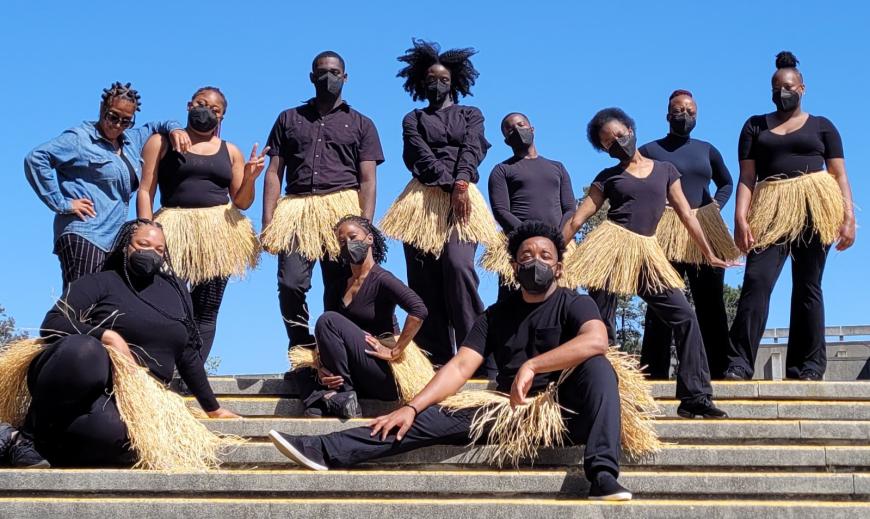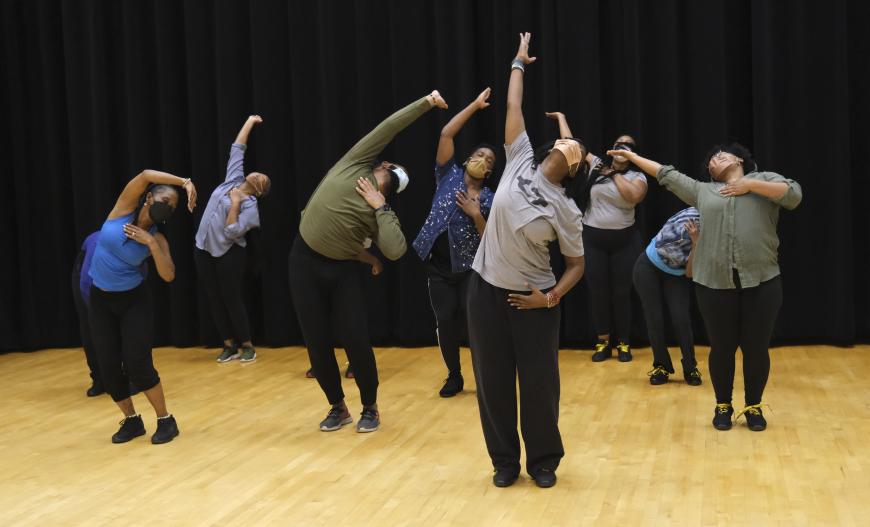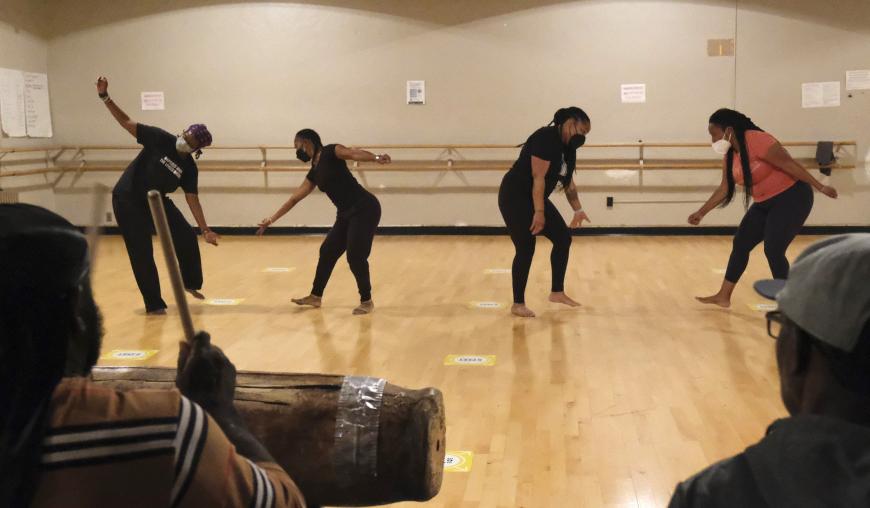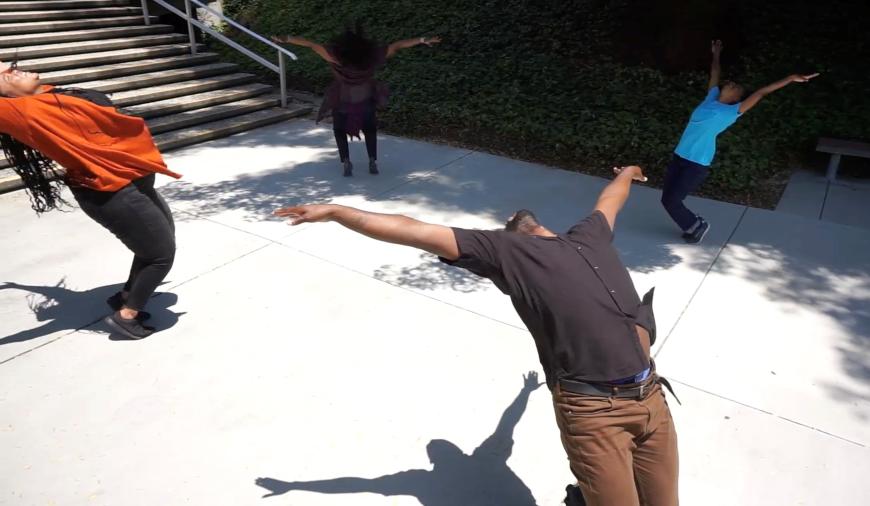
Describing ruminations. [re]visited, featured in Dimensions Dance Theater’s 50th-anniversary performances Oct. 22 and 23 at Mills College in Oakland, choreographer Laura Elaine Ellis sounds exhilarated, calling it a “fascinating journey.” Like so many who work with the company, Ellis expresses “full-hearted gratefulness for the support of Deborah B. Vaughan and my fellow Dimensions company members for their grace, resilience, and dedication, hanging with me through this artistic journey.”
Ellis’s work is one of two premieres on an anniversary concert that represents DDT’s core ideas. Under the artistic leadership of co-founder Vaughan, the company has established an international standing, with a mission to draw attention to African and African American dance traditions.
Realizing the staged version of ruminations. [re]visited, which was commissioned by DDT in 2019 as a project with filmmaker Desiree Galvez and later became a site-specific installation, has been inspiring for Ellis. “I’m seeing the opportunity to collaborate and to explore what the dancers, poets, and lighting designer will create along with me,” she says. “The most challenging thing for me is capturing elements that resonated artistically and figuring out how to get some of that expressed in the stage setting. For example, the layering effects in the film, breaching the fourth wall as we did in the site-specific version. I’m excited to see what we will imagine and bring forth and to witness what the audience will experience.”

Also highlighted on the program at Mills is Dai Zoe Bush — The Breaking of the Poro & Sande Bush by Nimely Napla. He is the former artistic director of the Liberian National Cultural Troupe and was recently awarded an ambassadorship by his native country. His work brings together Liberian dancers and musicians with dancers from Dimensions’ professional company and young participants from Dimensions’ Rites of Passage educational program.
Napla, in an email interview, explains the work’s origins: “From the Vai ethnic group in Grand Cape Mount County, every four years they have the bush school called, ‘The Breaking of the Sande Bush.’ The female youth learn how to respect and learn the way of life. At the end of the full year, there is a huge celebration to acknowledge them entering their next phase of life. [So] this work is primarily about celebration.”
Napla notes that many of the intricacies of these societies are sacred and kept secret, with knowledge only shared with other initiates. Similarly, there’s a counterpart for males in the Poro secret society, responsible for initiating boys into manhood.
So the choreographer had to receive special permission from tribal elders to replicate the full-body masks believed to embody divine spirits. He is one of only six people living in the United States initiated and allowed to make the masks, regalia, and dances representing these societies.

He writes, “Masks are an essential component of these widespread associations. Masked performers not only appear during initiation ceremonies but many other important social occasions. The masks worn by Sande and members possess unique characteristics and embellishments while adhering to established aesthetic criteria. Sande masks represent the epitome of female beauty; moreover, Sande initiation masks perform certain functions and play a central role in Sande ritual activities. The costume masker embodies the spirit of Sande, representing the society’s principles and ideals.”
About Dimensions, Vaughan says that the company was started in the late 1960s (and formalized as DDT in 1972), partly to promote appreciation of African ethnic dance.
“Traditional ethnic dance forms at that time got little recognition, and sadly that remains true today,” says Vaughan. “The idea of exploring tradition was not popular then; moreover, critics did not have much insight or understanding of the African diaspora, let alone a unique and relevant African American dance perspective. It was definitely a challenge to be Black, female, and presenting work from an African American lens. I wanted to break that barrier and not be stereotyped or put into a box.
“My travels throughout West and Central Africa, the Caribbean, South America, Asia, and the United States helped me realize I did not need permission from the mainstream dance world to validate or approve my vision. My motto became ‘Just do the work.’ I gave myself permission to collaborate with dancers and other artists, firm in the knowledge that we had a wealth of enduring stories, scenarios, dances, and traditions to investigate and present. Through the company’s collaborations, I’ve explored how the African diaspora spans and reverberates throughout the world and speaks to the human condition.”

As she continues to lead the company into its second half-century, Vaughan focuses on art that “transcends cultural barriers, art that heals and brings people together, art that helps us understand that we all have a valued history that we can understand and appreciate.”
In the Bay Area, where the costs of living are hitting organizations in communities of color with disproportionate impact, Vaughan says building a diverse, vital, sustainable arts ecosystem is imperative. “Funding is being given to larger and well-known groups, but if funders knew of our value and what we all do through our work [including arts education, community engagement, violence prevention, healing, and more], more funds could and should be given to organizations that are making that difference. Organizations of color that don’t have larger platforms need to be funded if we want them to succeed.”
Vaughan emphasizes her gratitude to dancers, choreographers, mentors, students, and audiences that have contributed to DDT’s long history. She celebrates the legacy that for 50 years has supported fearless artists who develop their craft with the company before moving on to pursue independent careers. “I believe, now more than ever, that art is urgent and a lifeline. I say to all artists of every genre that we have always been innovators and these times require that we continue to do our work. We must be fearless and bold. Listen to your inner voice; create, perform, present, and forge a way for the future. Know that the power of art and creativity is unstoppable.”




